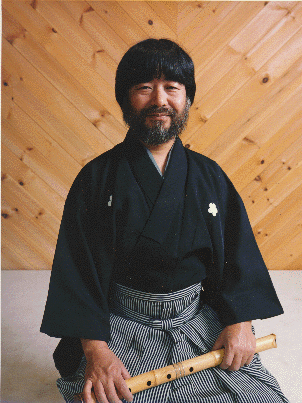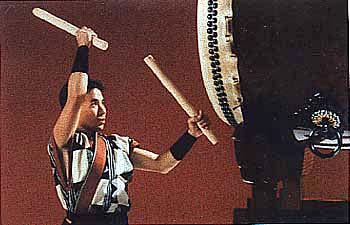
The shakuhachi is an end-blown bamboo flute with five holes. Although simple in appearance, the shakuhachi demands a playing technique that is very complex. It is reputed to be one of the most difficult instruments to master. Basically, the scale of the flute is pentatonic, but by partially covering the holes or tilting the head up or down, a large range of tones is possible.
The history
of the shakuhachi in Japan goes back nearly 700 years. In the
Meian school, which was the earliest school of shakuhachi, the
flute was used as a Zen Buddhist meditation practice. The two
major schools of today are the Kinko and Tozan. The Kinko School
has more depth of tradition and is approximately 250 years old.
It is distinctive for classical pieces of the Honkyoku style (the
honkyoku scale contains 60 notes within the western-style octave).
The Tozan School is about 70 years old. Developed in response
to western influences of the turn of this century, the Tozan School
incorporates western musical theory into its music.

A master shakuhachi artist,
Masayuki Koga is considered one of the finest players in the world.
In 1967 while he was a member of Ongaku Shudan in Tokyo his performance
and recording of the group received the highest Prize of the Arts
Festival by the Educational Ministry of Japan. In 2001, he was
recognized and honored the Award from the California Arts Council
for his contribution, leadership, and sacrifice for the youth,
the next generation of artists, and all citizens of the state
of California. He studied Kinko School Shakuhachi with is father,
Kiichi Koga, and Tozan School with master Kazan Sakai in Tokyo
where he received his master-teacher degree with highest honors.
Currently he is the Artistic Director of Essence and General director
of the Japanese Music Institute of America.

The virtuoso Koto artist
and composer, Michiyo Koga has performed and recorded many times
in Japan, Germany and the United States. She has worked with many
artists and ensembles, including serving as accompanist to Isaac
Stern while he was recording in Japan. Michiyo Koga has been playing
Koto since childhood, having first performed in Tokyo at the age
of 2. She has received formal instructions in piano since she
was 5, as well as voice since the age of 15. In 1970, she received
her Ikuta Style Koto Teacher's license. Also in 1977 she graduated
from both the NHK Japanese Traditional Academy of Music and Senzoku
Gakuen University of Music in Tokyo. Currently she is the Artistic
Director and principal Koto instructor of the Japanese Music Institute
of America.

Synthesizing traditional
Japanese drumming, world rhythms, and improvisation, taiko artist
Kenny Endo is one of the leading forces in contemporary taiko
performance. He holds the distinction of being the first non-Japanese
national to receive a Stage Name (Mochizuki Tajiro). He has traveled
to Russia, Egypt, Canada, Europe, and throughout Japan and the
U.S. performing. He established the Taiko Center of the Pacific
in Honolulu in 1994. He is also the Artistic Director of the Kenny
Endo Taiko Ensemble.
The taiko master artist,
Hiroyuki Jimi Nakagawa arrived in the United States in 1981. He
spent seven years studying jazz and performing with local bands
before joining the San Francisco Taiko Dojo in 1987, directed
by Grand master Seiichi Tanaka. In 1998 he returned to Japan to
continue his study of taiko and performed with Sukeroku Daiko
Hozonkai and master Kenjiro Maru of the Wakayama style festival
music. He also has studied with the celebrated jazz drummer Robert
Kaufman, former Professor at the Berklee College of Music. Hiroyuki's
refined but driving stick work has been featured in film, video,
and on stage. He has collaborated with many other well-known artists.
He is currently performing with and is an original member of Somei
Yoshino Taiko Ensemble.